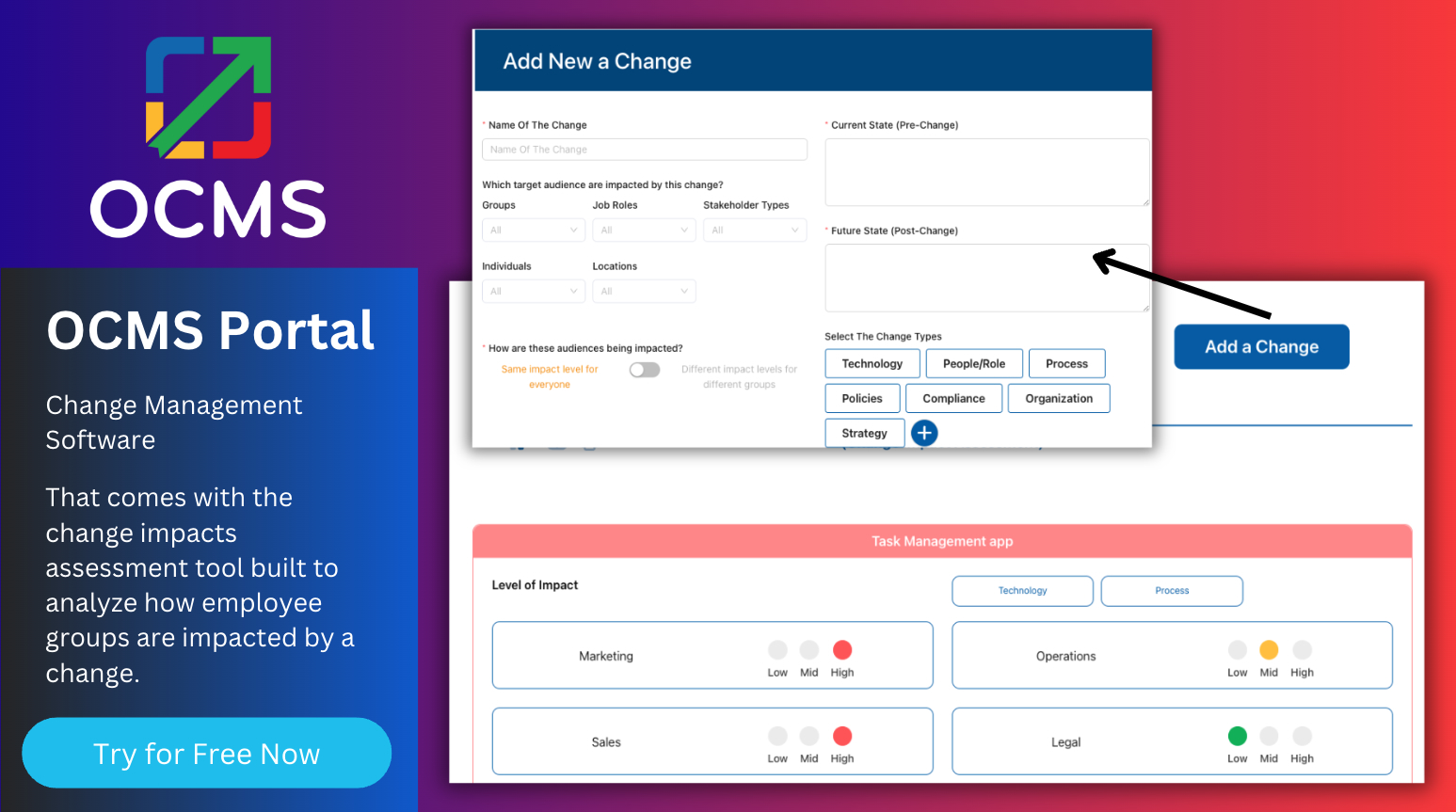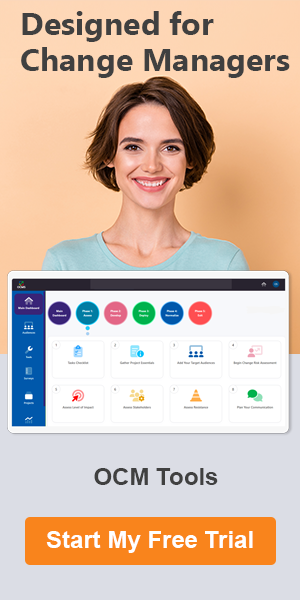Everything You Need for the Best Business Impact Assessments (BIA). Step-by-Step Guide, Business Impact Analysis Template & Report

Navigating Business Impact Analysis – Your Unseen Superpower
Enter the realm of Business Impact Analysis (BIA), a hidden gem in the world of business strategy that can bestow upon you the power of foresight and resilience. Imagine it as your invisible superpower, enabling you to anticipate and counteract the tumultuous waves of change and disruption that affect your organization.
In this all-encompassing guide, we’re about to unveil the secrets of BIA complete with business impact examples and show you how it can be your organization’s greatest ally.
Whether you’re preparing for a strategic overhaul, akin to a superhero refining their abilities, or bracing for unexpected challenges, like a guardian protecting their realm, BIA is the cape you wear to ensure your business’s survival and success.
Get ready to embark on a journey that equips you with the knowledge and tools to anticipate, adapt, and conquer any challenge that comes your way. Are you prepared to tap into the hidden potential of Business Impact Analysis? Let’s dive headfirst into this thrilling adventure!
Eager to catch a sneak peek of what lies ahead? We have a brief overview prepared for you shortly. Brace yourself to delve into the finest tips and strategies for Business Impact Assessments as we progress through the remainder of this guide.
Quick Summary
BIA Explained: The Significance of Business Impact Analysis
A BIA, or Business Impact Analysis, is a process used in organizational change management and business continuity planning. It involves collecting information about various aspects of a business, such as systems, processes, functions, and personnel, to understand how they may be affected by an event. The primary purpose of a BIA is to mitigate the risk of business disruption caused by an event or crisis.
A BIA helps create a matrix to guide the organization in minimizing negative impacts.
Its goal is to ensure the continuity of operations and organizational resilience during any event, whether planned or unplanned. BIA is applicable in different areas of organizational operations and industries, such as disaster preparedness planning and organizational change management.
A BIA is needed for various purposes, including:
1. Evaluating the impact of organizational change.
2. Preparing for natural disasters.
3. Mitigating potential technology disruptions.
4. Enhancing security for banks, governments, etc.
5. Proactively preparing for potential operational threats.
6. Improving business continuity.
Different types of business impact analysis methodologies may be tailored to specific uses, such as information technology, project and change management, or banking.
Despite variations, they all share the core objective of identifying potential areas of impact on business from specific events.
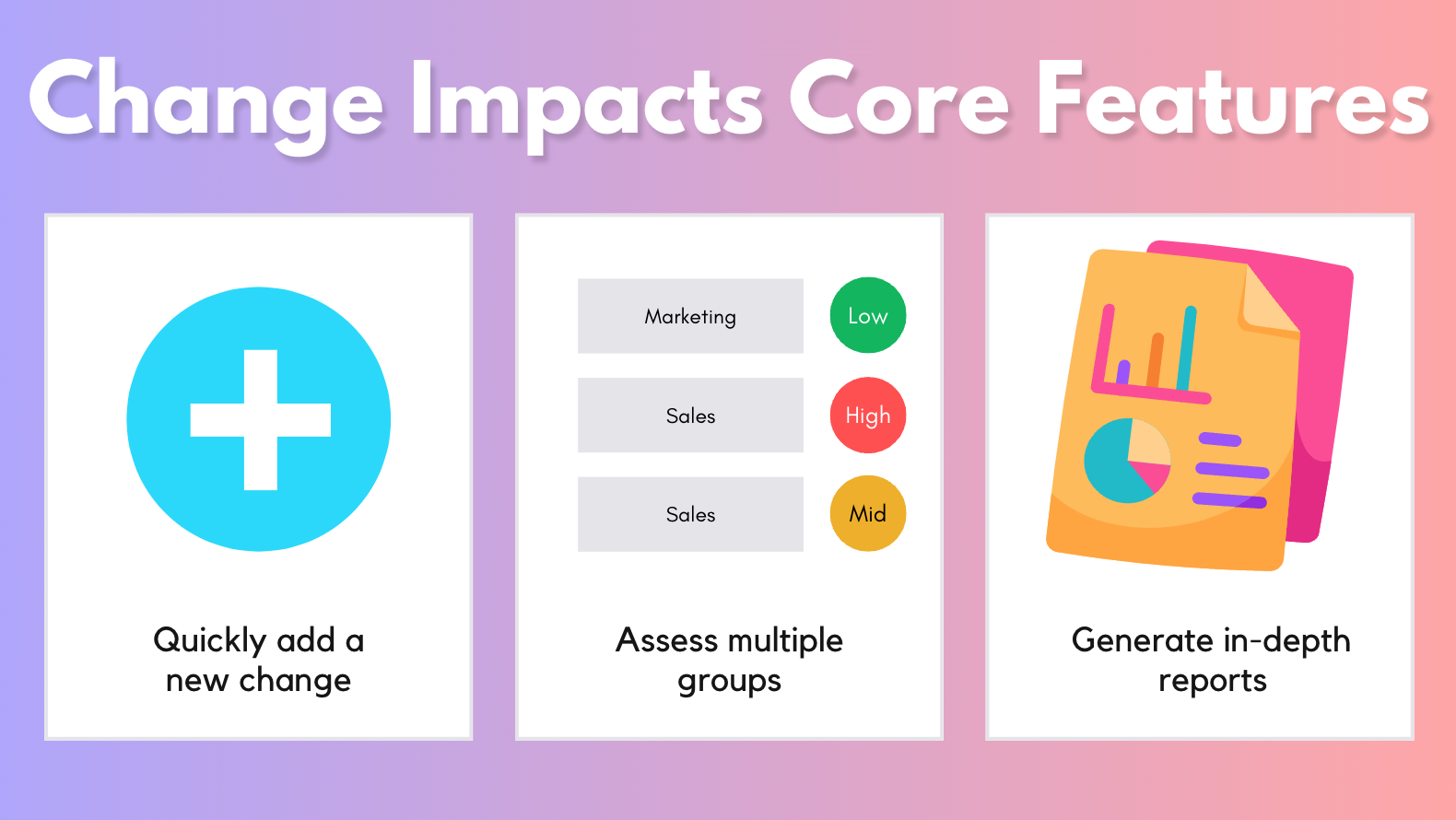
Facing Excel’s complexity for change impact assessments? Meet OCMS Portal, your all-in-one change management solution. It includes the Change Impacts Tool for simplified analysis complete with business impact analysis samples and more. Sign up free today – no credit card needed. Ready to start?
BIA Explained: Understanding Areas of Business Disruption
A Business Impact Analysis (BIA) involves evaluating five core areas within an organization that can be affected by various events or planned changes:
- Technology: This area covers disruptions to the technology infrastructure, such as system upgrades or changes that may lead to technology downtime, backend implementation, or impacts on user training.
- People: The “people” area assesses how individuals, including employees, managers, customers, vendors, and others, are impacted by an event or organizational change. For instance, it considers adjustments needed for employees to adapt to new processes or workflows, such as remote work during a pandemic.
- Process & Policy: Any event that necessitates changes in policies or processes within an organization falls under this category. For example, implementing a biometric entry system would require updates to policies and procedures related to building access.
- Organization: The “organization” category addresses disruptions that significantly impact the structure or makeup of an organization, such as mergers or downsizing due to economic factors.
- Business Strategy: This area involves changes that impact an organization’s strategic direction. For instance, altering the product line to emphasize sustainability or transitioning from in-person sales visits to virtual interactions represents changes in business strategy.
Understanding these areas of disruption is crucial for effective risk mitigation and for tailoring strategies to minimize the impact of an event or change on each specific area within an organization.
Navigating Business Impact: A Closer Look at Definitions
Defining business impact involves understanding how any event, whether planned or unexpected, can alter the existing processes and operational activities of an organization. These impacts can be positive or negative, and a business impact analysis (BIA) helps assess and prepare for them.
Positive impacts might result from transformational changes aimed at increasing profitability, while negative impacts could come from various disruptions like power outages, data breaches, or other threats. BIA is essential for preparedness, such as developing disaster recovery plans.
Various types of business impact include:
- Merger/acquisition
- Downsizing
- Expansion
- Transformational change
- Adoption of new technology
- Climate change events
- Physical damage to buildings or infrastructure
- Equipment or machinery breakdown
- Supply chain interruption
- Pandemic and stay-at-home orders
- Major data loss
- Cybersecurity incidents
- Theft (internal or external)
- Changes in the product line
Understanding and analyzing these impacts help organizations plan and respond effectively to minimize negative consequences and harness positive changes.
The OCMS Portal organizational change management software includes the Change Impacts Assessment tool designed to analyze how employee groups will be uniquely impacted by a change. Try it for free today (no credit card needed).
Business Impact Analysis: A Comprehensive Approach
To conduct a Business Impact Analysis (BIA), several essential steps and tools are involved:
- Identify Potential Event: The first step is to identify the event, whether it’s a crisis, planned change, or any anticipated or unexpected occurrence that could impact the organization.
- Gather Information: Collect information related to the event, its potential impact, and the areas within the organization that might be affected.
- Input Information into a BIA Template: Utilize a BIA template to organize and input the data gathered from various sources. The template can be in the form of a spreadsheet, a cloud-based tool, or another format that suits your needs.
- Analyze Information and Create a Comprehensive Report: Analyze the data within the BIA template to assess the potential impact on different aspects of the organization. This involves examining how the event could affect technology, people, processes, policies, organization, and business strategy.
- Present Business Impact Analysis Example Report & Recommendations: Compile the results of the analysis into a comprehensive report. This report should provide insights into the duration of downtime, the number of impacted processes and users, severity levels of impacts, and the number of affected job roles. It is crucial for presenting the findings to decision-makers.
Key tools for conducting a BIA include:
- Business Impact Analysis Questionnaire: This is used to gather information from subject matter experts, operational managers, and individuals with in-depth knowledge of specific areas within the organization. It ensures that the assessment reflects the ground-level impact on various departments, such as customer support, production, IT, accounting, HR, research and development, logistics, compliance, and operations.
- Business Impact Analysis Template: A BIA template allows you to organize and categorize data collected from the questionnaire and other sources. It can take various forms, such as spreadsheets or cloud-based tools, as long as it facilitates the correlation of data and follows the BIA methodology.
- Business Impact Analysis Report Template: This reporting template compiles the data and generates meaningful results that can guide decision-making. It includes key metrics related to the impact, such as downtime duration, affected processes and users, severity levels by division, department, or group, and the number of impacted job roles. Tools like OCMS Portal’s BIA template can automate report creation, saving time and enabling more timely decision-making for impact mitigation.
A well-executed BIA and recovery time assessment are crucial for effective planning and preparedness, whether the event is anticipated or unexpected.
It helps organizations understand the potential impacts and provides actionable insights to mitigate disruptions.
The ABCs of Business Impact Analysis: Steps to Success
Conducting a Business Impact Analysis (BIA) involves several key steps, regardless of the type of impact being assessed. These steps are as follows:
- Identify Resources for BIA Template & Analysis: Gather both digital and human resources necessary for the BIA. Identify key personnel and experts who can provide insights and relevant data. Ensure that you have access to the tools and templates required for the analysis.
- Conduct Information Gathering for Business Impact Analysis: Create a questionnaire for collecting information and send it to the identified experts and stakeholders. Additionally, gather data from various document resources, such as policy manuals and project assessments. This step aims to accumulate comprehensive information about the potential impact of an event or crisis.
- Document Findings of Business Impact Assessment: Input the gathered information into a BIA template, such as an Excel spreadsheet or a cloud-based tool. This documentation phase allows you to organize and consolidate the data for further analysis.
- Validate Findings with BIA Business Resources: Review your findings with the key resources who provided the data through the questionnaires. This validation step ensures that your interpretations are accurate and allows you to incorporate any additional data or insights provided during the review.
- Chart Impact on Business in a Business Impact Analysis Tool: Create charts, pivot tables, and graphs to visualize the impact on various aspects of the organization. Use metrics relevant to the type of analysis, such as recovery time, risk assessment, or severity levels. The goal is to present the data in a format that decision-makers can easily understand.
- Present BIA Analysis Findings & Recommendations: Compile the findings and insights into a final report. The report typically includes an executive summary, details about the methodology used, the current state and future state of processes/systems, analytics, priority of impacts, financial information related to risks and potential losses, and recommendations based on the analysis.
Each of these steps is crucial for a thorough BIA, allowing organizations to identify potential areas of impact, assess their severity, and make informed recommendations for mitigating disruptions and improving business continuity. The specific questions and data to be collected may vary based on the nature of the impact and the industry, but the overall process remains consistent.
Detailed Deep Dive
There are multiple events that can cause a disruption in business-as-usual at an organization. Some of these events are desired changes for growth that cause temporary disruption, while others are undesired events that can cause long-term disruption if not properly planned for.
Proper planning for any type of business impact from an event is done using a business impact assessment and analysis. This provides a way to anticipate how a particular event will have an impact on business and formulate risk mitigation strategies.
A business impact analysis example covers the who, what, when, and how of disruption in business operations. Understanding who will be impacted, what processes need to change due to an impact, and how to best handle the impact, allows organizations to mitigate costs and downtime.
BIA, business impact analysis, also helps identify areas that need attention during any type of business change or event. When you use business analysis templates to understand the areas and severity of an impact, it gives you a roadmap to formulate strategies to minimize the disruption.

What Does BIA Stand For?
Who Can Use a BIA Business Impact Assessment?
Any type of business or organization can benefit from knowing how to do a business impact assessment. Beyond typical commercial business change or disruption, an operational impact assessment template can be used in social work, climate change assessment, privacy groups, environmental sectors, government, and multiple other sectors.
The basic answer to, “What is a BIA?” is that it’s a method to reduce risk, guide change, and improve business continuity. The need to understand business impacts and how to adjust for them, recover from them, and mitigate disruption applies to anyone.
This Business Impact Analysis and Risk Assessment Guide
If you’ve ever asked, “What is a business impact analysis?”, then this guide is going to tell you everything you need to know about mitigating costs and productivity drops, and how to use business impact analysis methodology.
Whether you’ve searched on the misspelling, “business impact analyse” or tried to find a business impact analysis template Excel spreadsheet, you’ll find answers here.
Some of the things we’ll cover in this OCM Solution article:
- What is BIA?
- What does BIA stand for?
- What is the business impact analysis?
- Business impact analysis steps
- Business impact analysis questionnaire
- Business impact analysis example report
- What is the best business change impact assessment tool?
Are you looking for business impact analysis template excel downloads or business impact examples or have questions about a business impact analysis questionnaire? Reach out anytime with questions.
What is a BIA? What Does BIA Stand For?
The BIA acronym isn’t familiar to everyone, but it is widely used when talking about organizational change management as well as business continuity planning.
What does BIA stand for? The BIA acronym stands for business impact analysis. This is a process of collecting necessary information about business systems, processes, functions, and people to identify how they may be impacted by an event.
Part of the business impact analysis definition involves the reason for doing the BIA analysis, which is to mitigate the risk of disruption in business due to an event or crisis. A business impact analysis matrix is put together that can be used as a guide to avoiding as much negative impact as possible.
The goal of reviewing a business impact analysis sample and conducting a BIA, business impact analysis, is to ensure continuity of operations and organizational resilience during any type of event, whether it’s planned or unplanned.
What is a BIA? | Different Use Areas
When answering, “What is BIA?” it’s important to know that the term is used in multiple areas of organizational operations and many different industries. For example, you will run across the BIA acronym during disaster preparedness planning as well as during organizational change management.
Businesses can be impacted by any number of different types of events, so a BIA and recovery time assessment is best if done as needed for any of these various circumstances.
What is BIA needed for?
- Gauge the impact of organizational change
- Prepare for natural disasters
- Mitigate potential technology disruptions
- Improve security for banks, governments, etc.
- Proactive preparation for potential operational threats
- Improve business continuity
As you can see, there can be many different types of business impact analysis methodology to match each specific use. People perform business impact analysis for information technology, use a business impact analysis template in project and change management, have a business impact analysis template for banks, and so on.
While a business impact analysis template for information technology may look slightly different than a business impact analysis template for banks, both will share the core features of identifying areas of the potential impact on business from a particular event.
What is a BIA in Terms of Areas of Disruption?
There are five core areas of an organization that can be impacted by an event, crisis, or planned transformational activity. In certain business impact analysis report template software, you’ll be able to designate which areas of a company are being impacted.
Whether you’re searching “business impact analysis template Gartner,” the misspelling, “business impact analyse template,” or “OCMS Portal business impact analysis template Excel,” if it’s important for you to differentiate which areas of your organization are being impacted, then you’ll want to make sure you have fields to capture these five areas.
Five areas of business impact disruption:
- Technology
- People
- Process & Policy
- Organization
- Business Strategy
In the screenshots below, you’ll see an example of how the OCMS Portal Business Impact Analysis Template Excel Tool allows you to designate the specific area of a business that will be disrupted by an event, in this case, it’s a change management project.
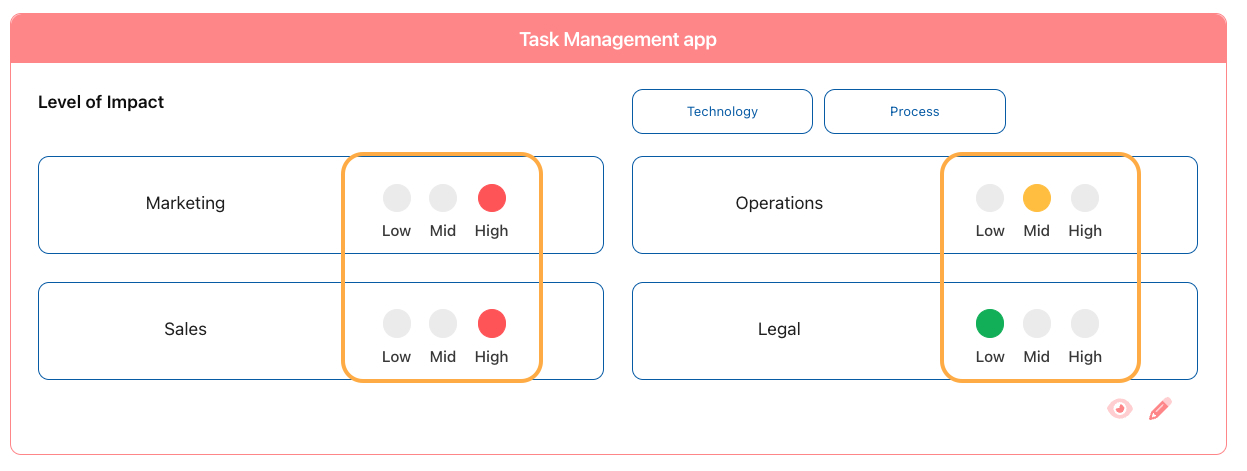
Sample Business Impact Template with Level of Impacts per Audience
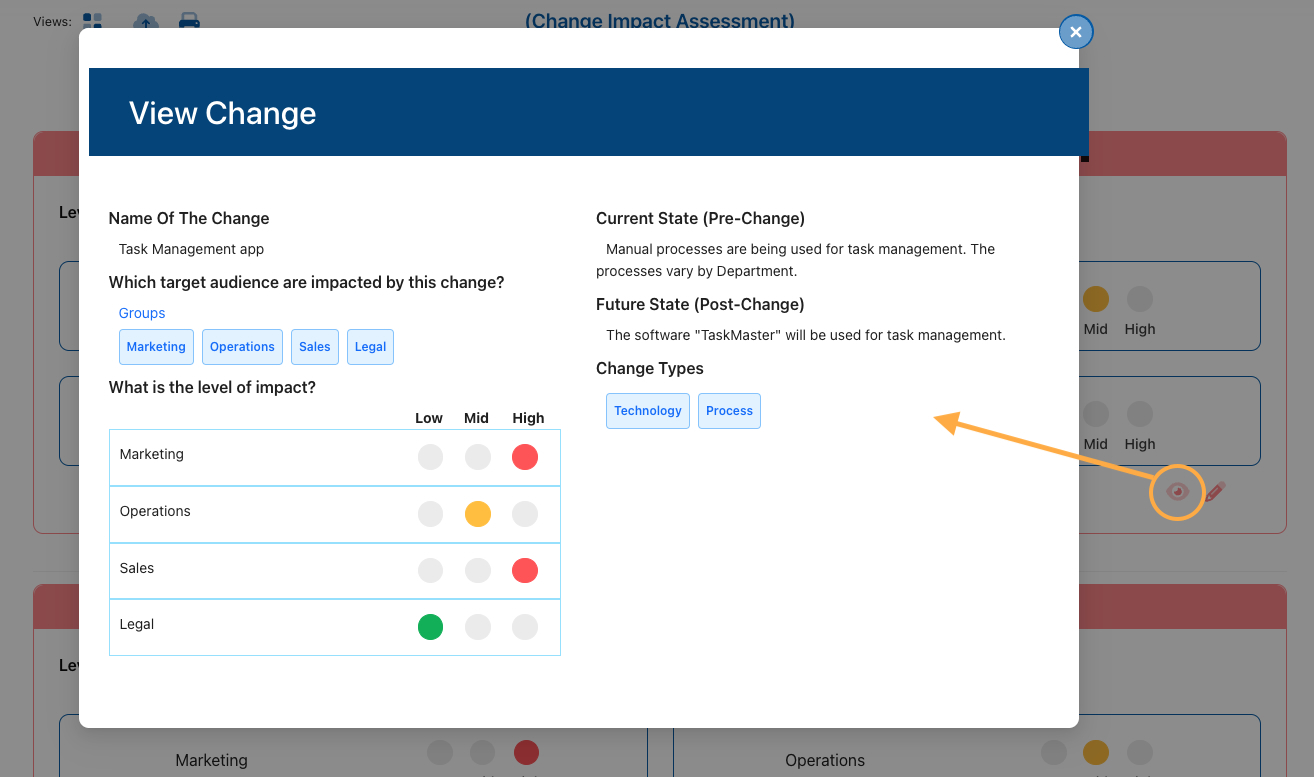
Cloud Based OCMS Portal Business Impact Analytics Tool
Why is it important to know the areas disrupted by the impact on the business?
Knowing this information will help you better target your risk mitigation tactics and activities designed to reduce the amount of impact.
When doing a business impact analysis example, you want to have a full understanding of exactly what’s included in each of these organizational areas.
Technology
Any part of your technology infrastructure that could be impacted by an event would fall into this “technology” area.
For example, if your organization is upgrading to a new ERP system or employee training software, then the technology area of your operations is going to be impacted.
An example of a business impact analysis for an IT infrastructure will include things such as technology downtime during a change, the time needed for backend implementation, and impact on users that need to be trained.
People
When answering, “What is business impact analysis?”, many times it’s something that’s going to identify how people are impacted by an event or planned organizational change.
People are nearly always impacted by any type of business change or operational disruption because they need to learn new processes, react to a crisis event, or adopt new daily workflows to accommodate a particular event.
An example of this would be the adjustment needed by employees and managers to accommodate remote working during the recent pandemic.
The “people” area of business analysis templates is for any changes impacting staff, managers, customers, vendors, or other human beings.
Process & Policy
Any events that cause an organization to change a policy, update a handbook, or change any type of process, would be considered a “process & policy” area impact.
What is a business impact analysis that causes a process/policy disruption?
An example would be if your organization is changing the way that employees entered the building, by adding a biometric entry system. This would require an update to procedures and policies that address the new process, i.e. what happens if an employee can’t get through the entry system?
Organization
When going through business impact analysis steps, one of the largest areas of disruption is “organization.” An example would be when a company is going through a merger that’s going to change how the business is run.
Another event that can create organizational impact to be addressed on a business impact assessment template is if a company needs to downsize due to economic reasons.
Any type of event that changes the makeup of an organization or an organizational structure would be in this impact category.
Business Strategy
When conducting a business impact analysis questionnaire for a BIA business impact analysis, you’ll also be looking for events or changes that impact a business strategy. Those types of disruptions would fall into the “business strategy” area.
One example would be if a business were going to change its product line and corporate mission to include an emphasis on sustainability. This wouldn’t necessarily mean any organizational structural change, but it would be a change to that organization’s business strategy.
Another example of a business impact analysis sample showing an impact of business strategy would be if a company used to rely heavily on sales teams that make in-person customer visits and was now changing their strategy to doing as much virtually as possible.
Do you need business impact analysis samples or business impact analysis report tool? Our Change Impact Assessment Template has robust analytics that you can export to a handy PDF report.
How Do You Define Business Impact?
We’ve covered the business impact analysis definition, now let’s look at how you define business impact.
A business impact would be anything that changes the “as is” processes and operational activities of an organization. This can be a crisis, a planned change, or any type of unexpected or expected event.
Not all impacts are negative. For example, there are many BIA business impact assessment activities done for transformational changes that will make a company more profitable.
In this case, the business impact analysis example report may include the expected advantages after the change and positive impacts on the organization.
Some business impacts are negative, and the BIA and recovery time assessment is best if done in advance so an organization can be prepared with a disaster recovery plan.
For example, it’s important to know which operational areas of a business would be impacted by things like a long-term power outage, a data breach, or any other type of disruptive threat.
A business impact analysis for information technology for a downtime event may include the identification of vulnerabilities to address, like a backup and recovery system or a recommendation for a redundant ISP provider.
Types of Impact to a Business
Here are a few of the standard types of impact on business for which you would want to use an operational impact assessment template:
- Merger/acquisition
- Downsizing
- Expansion
- Transformational change
- Adoption of new technology
- Climate change events
- Physical damage to buildings or infrastructure
- Breakdown of equipment or machinery
- Supply chain interruption
- Pandemic and stay-at-home orders
- Major data loss
- Cybersecurity incident
- Theft (internal or external)
- Change in the product line
How Do You Do a Business Impact Analysis?
Whether you use a business impact analysis template Gartner design or an OCMS Portal sample business impact analysis report, you need to cover the following basics:
- Identify potential event
- Gather information
- Input information into a business impact analysis template
- Analyze information and create a comprehensive report
- Present business impact analysis example report & recommendations
A business change impact assessment is typically done using a few key tools that will help you gather information, assess the information, and share it in comprehensive reporting metrics with a decision-making team.
1. Business Impact Analysis Questionnaire
One of the tools used for a business impact analysis and risk assessment would be a business impact analysis questionnaire. This is sent to key subject matter experts, operational managers, and anyone else in an organization that’s familiar with how something might impact their specific area of operations.
The goal is to give a business impact analysis questionnaire to anyone who has the most accurate knowledge about a process in an organization.
For example, rather than only getting input for your business impact analysis report template from executives that aren’t involved in the day-to-day “on the ground” operations, you would want input from someone like a plant manager, HR director, or IT manager.
A few examples of the organizational areas that you would need input from when putting together a business impact analysis matrix include:
- Customer support
- Plant or production
- Information technology (IT)
- Accounting
- Human resources
- Research & Development
- Shipping & logistics
- Compliance
- Operations
No matter what type of impact or disruption you’re assessing, you will need to know the impact on business at the ground level from all the pertinent departments.
2. Business Impact Analysis Template
Another important tool to use when taking business impact analysis steps to identify and mitigate potential operational disruptions is a business impact analysis template.
What is a BIA template?
It is a tool that allows you to input all the data from your business impact analysis questionnaire and data collected from other sources on the potential impact an event would have on an organization.
A BIA business analysis template can be in the form of a spreadsheet, a cloud-based tool, or in another format. The main thing is that you want something that will allow you to correlate all your data so you can present the results of your business impact analysis example comprehensively.
There are any number of business analysis templates you can find when searching on things like, “template for business impact analyse” (misspelled), “business impact analysis template Excel,”, “business impact examples” or “What is business impact analysis template?”
The key is to find a BIA template that allows you to categorize the data in a way that’s meaningful and that follows business impact analysis methodology.
What is a business impact analysis template that’s good to use for this purpose?
OCMS Solution offers a comprehensive business impact assessment template in a cloud version (OCMS Portal) and a business impact analysis template Excel version. Both follow the business impact analysis methodology and give you everything you need for conducting a BIA business impact assessment.
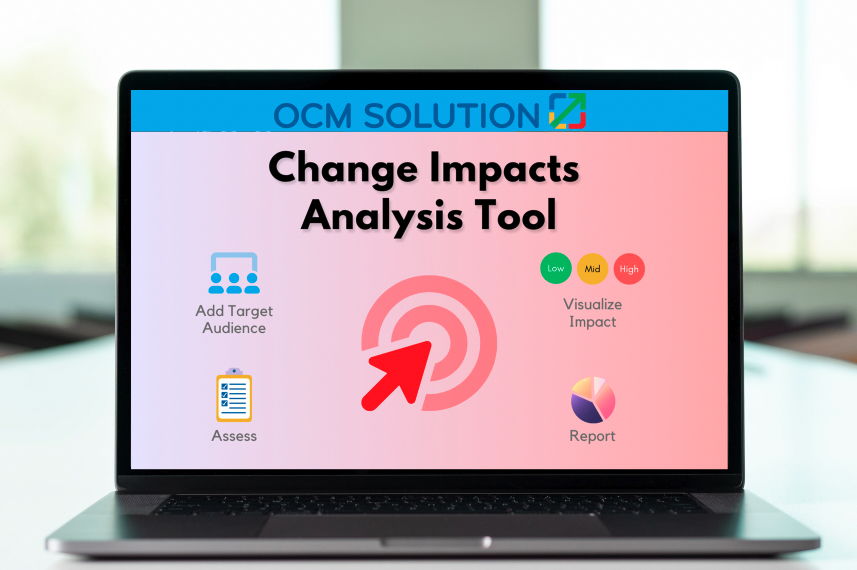
OCMS Portal Operational Impact Assessment Template
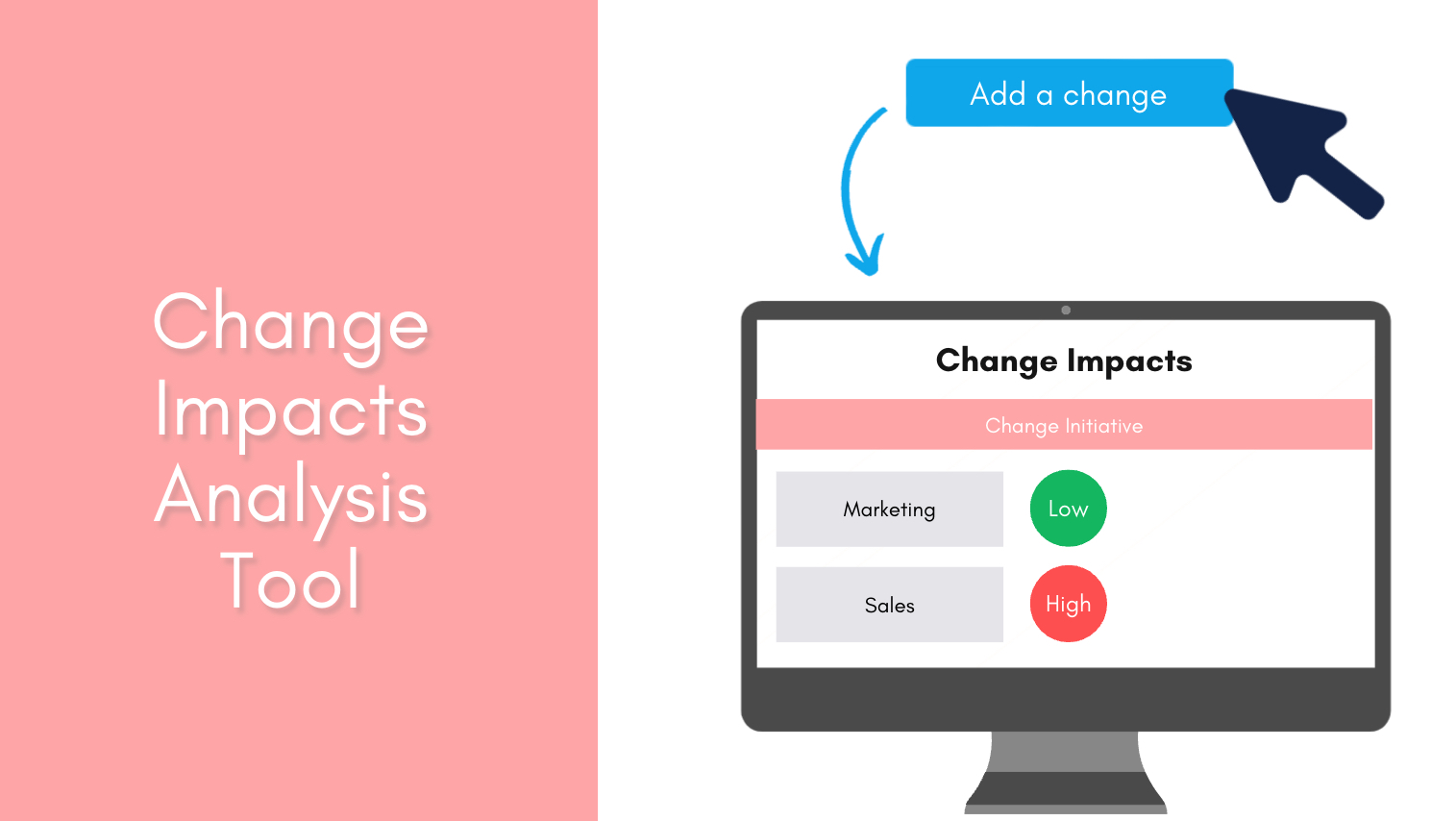
OCMS Portal Business Impact Analysis Sample Template for Data Input
3. Business Impact Analysis Report Template
The final tool that is important when conducting a business change impact assessment or any other business impact analysis and risk assessment is a reporting template.
Data gathering and input is only part of the whole business impact analysis definition. The data needs to be aggregated into meaningful results from which action can be taken.
In an example business impact analysis for an IT infrastructure, important reporting metrics would be things like:
- Duration of downtime by department
- Number of impacted processes and users
- Severity level of impacts per division, department, group
- Number of impacted job roles
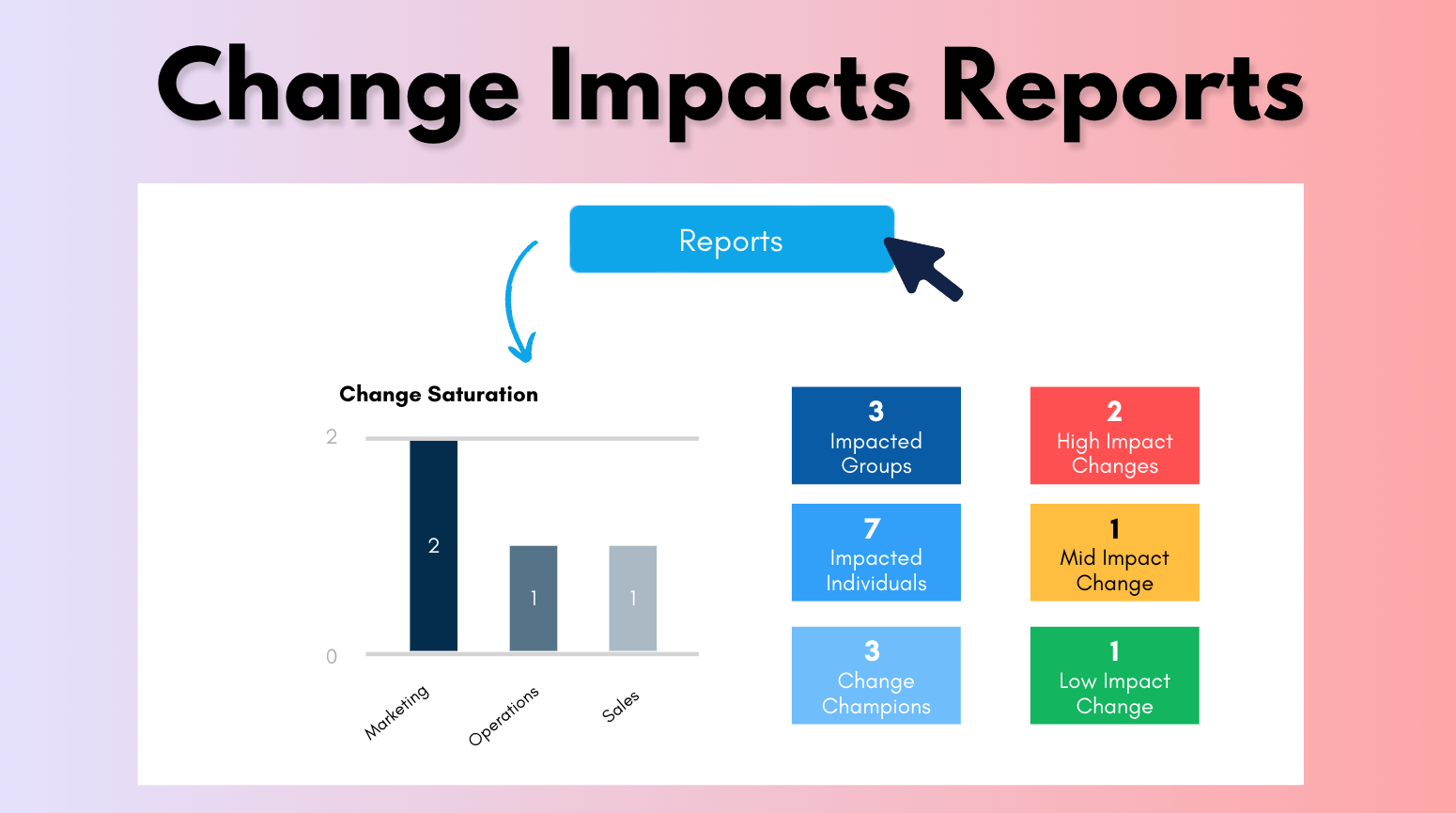
Sample Business Impact Analysis Report Template
While you can chart all metrics from your business impact analysis template for banks, retail firms, tech firms, or another industry from scratch yourself, it’s much easier to use a tool that does it for you automatically.
For example, when you use OCMS Portal’s business impact analysis template and tool, your reports will be created automatically as you enter data.
This saves valuable time for conducting a business impact assessment because there is no lag time between when data is entered and when you can present a comprehensive business impact analysis matrix report to decision-makers.
A BIA and recovery time assessment is best if done well in advance of an event occurring. However, this is not always the case. So, being able to reduce the time from data collection to data reporting can be a huge benefit and help organizations make more timely decisions for impact mitigation.
What are the Steps in a Business Impact Analysis?
There are several steps you’ll take when conducting a business impact analysis for information technology, organizational change, disaster preparedness, or any other potential impact area of an organization.
The tasks inside each step may differ according to the type of impact on the business you’re assessing and the industry.
For example, a business impact analysis template for information technology will include steps related to software, IT personnel, and bandwidth needs. On the other hand, a business impact analysis template for banks would include steps related to physical money transfers and security procedures.
But whether you’re looking for a business impact analysis template Gartner offers or are looking for a business impact analysis example from OCM Solution, or making your own spreadsheet, the following steps will apply, no matter the industry or impact type.
What is Business Impact Analysis? | Steps to Take
- Identify Resources to Use for BIA template & Analysis
- Conduct Information Gathering for Business Impact Analysis
- Document Findings of Business Impact Assessment
- Validate Findings with BIA Business Resources
- Chart Impact on Business in a Business Impact Analysis Tool
- Present BIA Analysis Findings & Recommendations
Next, we’ll go into more detail about each of these business impact analysis steps.
Step 1: Identify Resources to Use for BIA Template & Analysis
Your first step in conducting analysis for impact on business is to get your resources lined up. This includes both digital resources and human resources.
When conducting information gathering for a BIA, business impact analysis, you need to identify those people who are going to have the key information you need to know.
For example, if your business analysis templates are based upon a change project, you’ll need information about what is being changed. This may come from the project assessment or key stakeholders and subject matter experts.
People Resources
You need to identify who to send your business impact analysis questionnaire to, which means detailing who may have the best knowledge in each area of an organization about a potential disruption or event impact.
Your “People Resources” will include those managers that are involved in the day-to-day operations of the organization and who would know the severity and duration of the impact caused by different types of events. They most likely have dealt with these types of things before.

What Does BIA Stand For? | BIA Template & Resources
Document Resources
When understanding what is a business impact analysis when it comes to policies and procedures, you should identify any document resources that may be of use for your BIA.
These could be things like:
- Policy manuals
- Data privacy compliance rules
- Employee process handbooks
- Organizational charts and mission statements
- Operations manuals
- Project assessments
- Climate reports
Tools/Software Resources
You’ll want to identify a good BIA template to use for the input of your BIA analysis data. Having this in place at the start will ensure that no unnecessary time is spent identifying a business impact assessment template to use once your assessment has already started.
You may want to go through a free trial or two of a business impact analysis sample software to find the one that’s going to fit your needs best. You don’t want to be doing this in the middle of your BIA business impact assessment or it will just slow you down and might result in rework.
A BIA and recovery time assessment is best if done after you have already chosen and put in place the tools/software resources you need for the project.
Step 2: Conduct Information Gathering for Business Impact Analysis
In the next step of a BIA business assessment, you’ll need to put a questionnaire together and send it to the key people resources you identified in Step 1. You’ll also begin gathering information from other sources, such as policy manuals and documents.
The goal of this business impact assessment step is to put together all the information you’ll need related to the potential impact of a planned event or an unexpected crisis so your organization can be properly prepared.
When you put together the questionnaire for impact on business analysis, it’s important to include as many questions as possible. Not everyone will immediately think of a particular key data point you may need to know on their own. The questions should be designed to prompt information critical to your business impact analysis template.
Remember that not everyone will know the BIA acronym or the business impact analysis definition. So be as clear as possible about the event you are doing the analysis for and the type of information you need related to how that event may impact business operations, people, processes, vendors, customers, organizational structure, business strategy, and any other areas.
Business Impact Analysis Questionnaire Example
While an example business impact analysis for an IT infrastructure may have a few different questions than the BIA analysis for a retail outlet, you can use the format below for each and just add the pertinent questions you need in each area.
- Department Information: Begin by collecting the basic department/area information such as names of contacts, etc.
- Department Process Information: Collect details on the exact processes or functions performed by that department.
- What are the Dependencies?: An important part of the answer to, “What is a BIA?” is to understand how processes and departments are interconnected. Ask what other areas of the company that department’s processes are dependent upon.
- Prioritize Processes by How Critical They Are: Not all processes in a department are as critical as another. Ask that the processes be prioritized by importance.
- Are Alternate Processes Available?: If there is a disruption to a process, can an alternate method be used instead? For example, if the front door keycode entry will be down during an upgrade, a security person may be a suitable short-term substitute.
- What Will Be the Negative Impact of Disruption?: Be sure to include all types of negative impacts, both financial and non-financial (such as, employee morale).
- Disruption Time that Can Be Accommodated: How long can the department’s operations be disrupted without a serious negative impact?
- Time to Recovery: This is used often for a business impact analysis template for information technology. Ask the time needed to recover to “business as usual” after a disruption in operations.
- How Much Capacity is Available? Some departments will be already overburdened and not have much capacity for a change or event impact. Other’s may be more flexible and accommodate a disruption with minimal negative affect.
- Monetary Impact: It’s important to know the monetary impact of a business disruption, and to know it according to the timeline. E.g. In most cases, a disruption of one day is going cost less than a disruption of one week.
- Special Considerations: Invite the person filling out the questionnaire for your business impact assessment to add any other special considerations you may not have thought about.
Step 3: Document Findings of Business Impact Assessment
Next, you’ll want to put together all the information that you gathered in your analysis of disruption in business into a business impact analysis example template. This allows you to document all the insights gathered from the questionnaires and document resources.

What is BIA? | Cloud Collaboration with BIA Business Tools
If you’ve properly followed Step 1, then you’ll already have a business impact analysis template Excel, cloud software, or another kind ready to go. Then it’s just a matter of entering data into the business impact analysis template.
If you have more than one person entering information into the same business impact assessment template, then instead of having to collate several different spreadsheets together, it’s much cost-effective time to use a cloud-based tool.
Using a business impact analysis methodology-based cloud template, like OCMS Portal Cloud Business Impact Assessment Tool, allows you to collaborate with others and see data in real-time as it is input from any location.
Step 4: Validate Findings with BIA Business Resources
Before you present your impact on business report and analysis to decision-makers and key stakeholders, you want to validate your findings with those key resources that filled out your BIA business impact analysis questionnaire.
Review your findings with these key resources to ensure you and your team properly interpreted their answers. This step also helps solidify to those who contributed a better understanding of, “What is BIA?”
Going through your business impact analysis sample with these department managers and other resources will often cause new potential data to come to light that should be included in your final BIA, business impact analysis, report.
As the final part of this review, update any additional data needed in your business analysis templates.
Step 5: Chart Impact on Business in a Business Impact Analysis Tool
If you’ve used a business impact assessment template that doesn’t have automated analytics, then you’ll need to create the pivot tables, charts, and graphs to help decision-makers understand your impact assessment.
The metrics that you want to show in charts and graphs may differ, whether you’re doing a business impact analysis for an IT infrastructure or a business impact analysis example for climate change impacts to an organization.
For example, in a business impact analysis template for information technology, you may want to include a metric for time to recover from downtime and the risk for data loss from a potential impact event.
A sample business impact analysis report should include as many different data analytics as possible to help decision-makers develop a plan for mitigating risk due to business disruption.
What is a BIA Business Impact Analysis Report Example?
Here is an example of a real-time report that is auto-generated from OCMS Portal’s Cloud Business Impact Analysis Template with analytics.
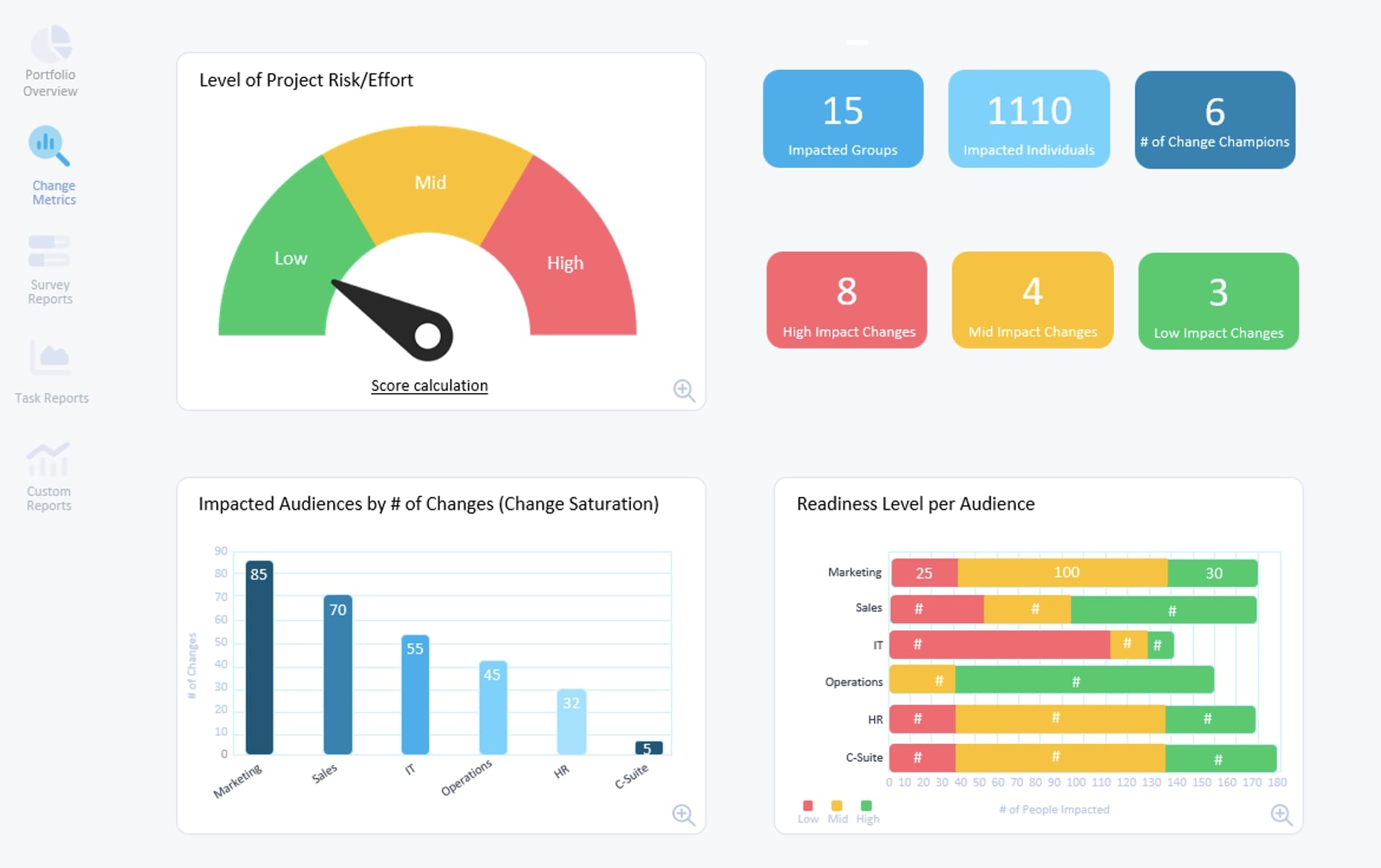
OCMS Portal | What is Business Impact Analysis Reporting?
Some of the business intelligence data that you’ll want to chart and to present in your impact on the business report include:
- Number of processes that are impacted
- Number of users/employees that are impacted
- List of impacted processes
- Number of divisions, departments, and/or groups that are impacted
- The severity level of the various impacted divisions, departments, groups
- The quantity and names of user roles that are being impacted or changed
By knowing where impacts on business are in an organization and how severe those impacts are, decision-makers know where to deploy resources to minimize the costs of those disruptions.
Step 6: Present BIA Analysis Findings & Recommendations
What is BIA’s last step? You’ll want to create a final report to present that includes the analytics from your BIA business impact analysis and any potential recommendations you and your team have based upon the data.
What is a business impact analysis recommendation? It could be something like a suggestion on a project rollout timing to prevent severe disruption in business operations.
Another type of recommendation that might come out at the end of your business impact analysis steps is a cloud technology recommendation to prevent long-term downtime in the event of a natural disaster.
What is the BIA protocol for a final report? It depends upon the reason you’re assessing business impact and the needs of the project and organization. However, if you’re going by standard business impact analysis methodology there is a general format of items to follow.
What is Business Impact Analysis for a Final Report?
Here are some of the elements that are typically included in a report for a business impact assessment template:
- Executive summary
- Details on methodology used for data gathering
- Detail of the “current state” and “future state” process/system/environment
- Analytics, charts, diagrams illustrating results
- Details on the priority of impacts by department, function, etc.
- Financial information related to risk, potential losses, etc.
- Detailed recommendations based on the business impact analysis
#1 Simple & Effective Business Impact Analysis Tool
There is a lot of detail involved when performing a business impact analysis. To ensure you capture all pertinent information and have useful analytics, it’s important to choose the best business impact assessment tool that you can.
You want one that is flexible to use the way that fits your workflow best. For example, being able to choose between a cloud version or business impact analysis template Excel version.
A tool that does the analytics and charting work for you in real-time as you enter data will save you hours and possibly days on your reporting analysis. You can also quickly see how new data impacts your overall business impact assessment results.
So, what is a BIA tool that can do all that? Look no further than the OCMS Portal’s Business Impact Assessment Tool!
Some of the features that you’ll find in this top-rated business impact software are:
- Cloud or Excel version to choose from
- A fully integrated database for input and analytics dashboard for reporting
- Ability to choose the area of impact for each process (i.e. people, technology, etc.)
- Free change management templates & roadmaps
- Ability to upload your data from a spreadsheet
- Real-time collaboration with team members (cloud version)
- Use on any device (cloud version)
- Helpful tips, guides, and instructions for those new to business impact assessment
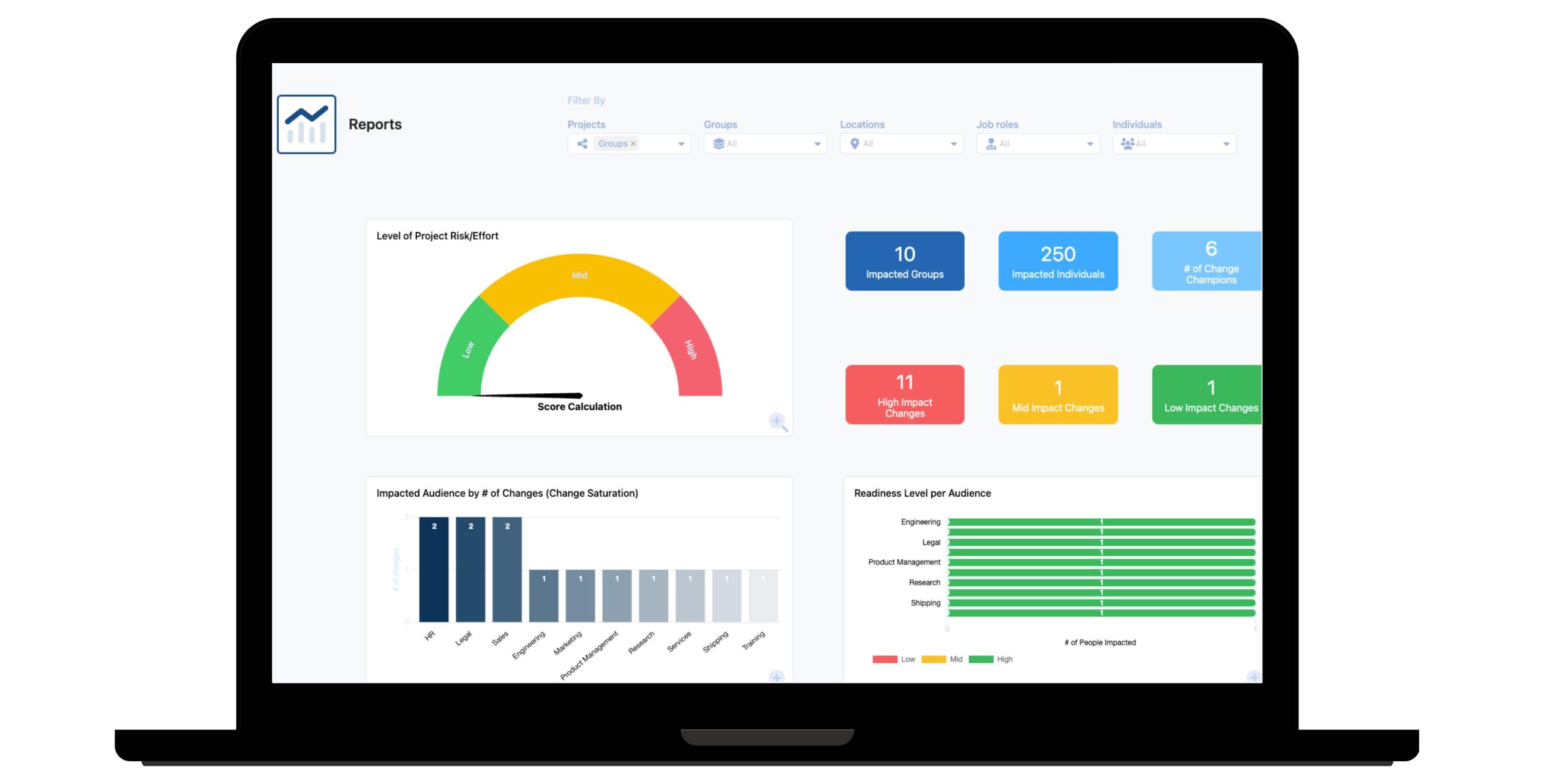
Purchase OCMS Portal’s Business Impact Assessment Tool Now!
Conclusion | Best Business Impact Analysis Template & Guide
No matter what type of event an organization is preparing for, the business impact analysis is one of the most important tasks to reduce disruption in business operations and financial losses.
Both planned events, such as an organizational change project, and unexpected events, like a pandemic, can be handled much more easily if a business impact assessment has been completed.
This allows organizations to answer questions, such as “What does BIA stand for when it comes to the financial impact of a change?” or “How can we make our organization as resilient as possible against a variety of impact types?”
One thing is certain, which is that the help of good business analysis templates can make an assessment of event or change impact on a business much easier to do, less time-consuming, and provide smart business intelligence insights.
We hope this step-by-step guide to conducting a BIA business impact assessment has been helpful and cleared up any questions you may have had about doing this type of important business analysis.
Business Impact Analysis Template FAQ
What are the steps in a business impact analysis?
There are several steps you’ll take when conducting a business impact analysis for information technology, organizational change, disaster preparedness, or any other potential impact area of an organization. Steps to conduct a business impact analysis: 1. Identify Resources to Use for BIA template & Analysis 2. Conduct Information Gathering for Business Impact Analysis 3. Document Findings of Business Impact Assessment 4. Validate Findings with BIA Business Resources 5. Chart Impact on Business in a Business Impact Analysis Tool 6. Present BIA Analysis Findings & Recommendations
Why is a business impact analysis important?
A business impact analysis is important because it helps organizations mitigate risk, prepare for organizational change, and minimize any business disruptions. Disruptions in business can be caused by both planned and unplanned events, and the results of a business impact assessment give companies the information they need to prepare for both types and ensure their operations are resilient and can easily recover.
How do you define business impact?
A business impact would be anything that changes the “as is” processes and operational activities of an organization. This can be a crisis, a planned change, or any type of unexpected or expected event. Not all impacts are negative. For example, there are many business impact assessment activities done for transformational changes that will make a company more profitable. In this case, the business impact analysis report may include the expected advantages after the change and how best to achieve the positive impacts expected.
How is business impact calculated?
Business impact is calculated using a variety of criteria that include things like: • Level of impact severity • Scope of the impact • Ability to use alternative processes when key processes are disrupted • The timeframe takes to recover from a disruption • How many processes a particular impact is changing • How many people or departments are impacted • The number of job roles being impacted or changed • Monetary losses of a particular impact
Note: Content on OCM Solution's ocmsolution.com website is protected by copyright. Should you have any questions or comments regarding this OCM Solution page, please reach out to Ogbe Airiodion (Change Management Lead) or the OCM Solutions Team today. OCM Solution was previously known as Airiodion Global Services (AGS).
Images: https://unsplash.com/photos/qWwpHwip31M, https://unsplash.com/photos/5QgIuuBxKwM,https://www.pexels.com/photo/photo-of-people-using-laptop-3194521/, https://pixabay.com/photos/application-request-ipad-tablet-1883453/



